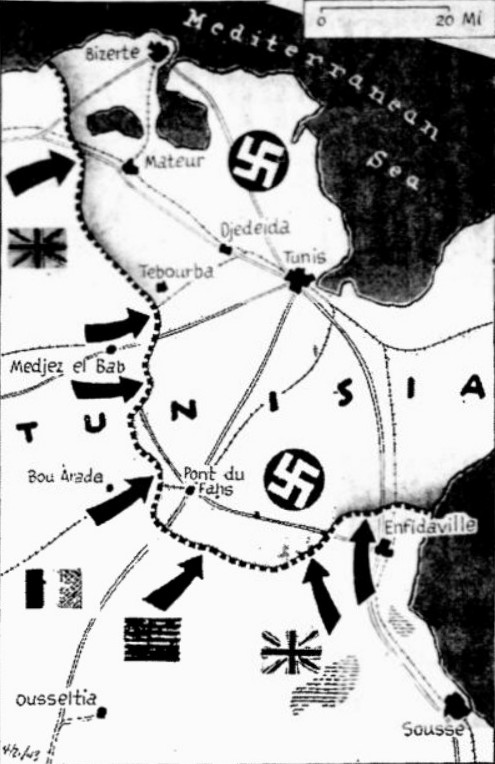The Pittsburgh Press (April 21, 1943)
British take Enfidaville; battle rages
Allies batter foe in air as 8th Army lashes Nazis’ best troops
By Virgil Pinkley, United Press staff writer
The trap tightens on the Axis armies defending Bizerte and Tunis as the British 8th Army captures Enfidaville and the British 1st Army gains north of Medjez el Bab.
Allied HQ, North Africa –
The British 8th Army has smashed through four furious German counterattacks to capture Enfidaville and all initial objectives in the first Axis mountain defense line 50 miles south of Tunis.
A great battle still raged today on the sweltering, rocky Tunisian coastal hills as Allied air forces pressed an unprecedented assault on the enemy and the British 1st Army jabbed the Axis western flank.
Using heavy artillery, Tommy guns, bayonets and knives, the men of Gen. Sir Bernard Montgomery scaled blood-bathed 1,200-foot Jebel Garsi, a dozen miles west of Enfidaville, and then cut suddenly eastward through a whirlwind of German artillery fire to the little Arab village of Takrouna, two miles west by northwest of Enfidaville, which the enemy abandoned. Gen. Montgomery quickly began moving up his heaviest artillery.
Four times the best German troops that Marshal Erwin Rommel could put into the field counterattacked fiercely but were thrown back with heavy losses to both sides. A dispatch from the front said the main battle was on a five-mile front between Takrouna and Jebel Garsi, where sweating, cursing troops are still locked in bitter battle.
The Allied offensive was supported by what U.S. and British headquarters officially described as:
…the heaviest and most destructive blows yet struck against enemy airpower in Tunisia.
The fury of the German counterattacks, all of which were broken up by the rampaging 8th Army, left no doubt that Rommel intended to fight to the bitter end on every rocky hillside and in every ravine guarding the openings to the plains around Tunis.
But the Allied forces, sparked by non-stop aerial attacks that brought down 27 more enemy airplanes on Tuesday for a three-day total of 151 destroyed, were striking from the west as well as through the Enfidaville sector on the south.
On the Medjez el Bab sector, less than 30 miles west of Tunis, the British 1st Army under Lt. Gen. K. A. N. Anderson, pushed forward again in local fighting and seized another town – Smidia – a few miles north of Medjez el Bab.
Axis broadcasts reported fighting “with a ferocity never before attained in the North African campaign” was raging in the Enfidaville sector, but acknowledged British gains which Radio Algiers estimated at three miles.
The four Axis counterattacks were made almost as soon as Montgomery launched his first moonlight advance Monday night, but Enfidaville and the important heights to the west, including Jebel Garsi, were occupied early Tuesday.
Despite the initial 8th Army successes, Rommel still holds a formidable string of ridges north of Enfidaville and Jebel Garsi which presumably make up his main defenses for Tunis.
The terrain around Enfidaville was the most difficult yet encountered by the 8th Army in its 2,000-mile pursuit of Rommel’s Afrika Korps from El Alamein, Egypt, and Allied observers here warned that any advance would be a slow and tedious business.
Rommel is known to have fortified the hills along the Enfidaville line with hundreds of guns, including nests of the deadly 88mm cannon that have served him so well in the past as well as mortars.
Montgomery chose a moonlit night to launch his Enfidaville offensive, even as he did to open his attacks on the Alamein and Mareth Lines. By coincidence, it was also the eve of Adolf Hitler’s birthday.
U.S. and British Air Forces continued heavy attacks on the enemy, especially along the road to Tunis in support of the 8th Army drive. Many vehicles were destroyed or damaged and communication centers blasted.
Reconnaissance photographs also showed excellent results from bombardment of Axis supply bases, especially in Sicily, where recent raids by Flying Fortresses sank or damaged at least 28 enemy supply ships.
U.S. and British Air Forces announced that:
The full weight of the Northwest African Air Force was turned against enemy airfields in the northeastern tip of Tunisia on Tuesday.
Flying Fortresses heavily bombed Sidi Ahmed on the outskirts of Bizerte, straddling the target with many sticks of bombs and starting large fires. Other Fortresses plastered La Marsa Airfield, 10 miles east of Tunis and shot down one Me 109. The Germans, however, had more fighters in the air than in recent days.
Mitchell bombers teamed up with Lightning escorts to hammer a landing ground halfway between Tunis and Bizerte. They also attacked 16 Fw 190s, which fled, as did three Me 109s. Other Mitchells bombed La Sebala, eight miles northwest of Tunis, hitting runways and starting fires.
Two other Mitchell bomber formations attacked two landing grounds between Tunis and Bizerte with “good results.”
The Tactical Air Force also had a big night. Wellington bombers of the RAF smashed at Creteville, 12 miles southeast of Tunis, and Soliman, while RAF Bisleys struck Sidi Ahmed.
Warhawks and Spitfires made many sweeps over the Gulf of Tunis and in a fierce dogfight near Cap Bon, they destroyed 19 enemy fighters without loss. The bag included four Ju 88s, six Me 109s and nine Macchi C.202s.
Beaufighters of the Coastal Air Force made intruder patrols over Sardinia on Monday night and shot up rail lines. One Beaufighter raked a freight train and others attacked a second train south of Sassari. Spitfires flown by Americans on escort duty destroyed six enemy fighters. At one time, a formation of 50 German Focke-Wulf fighters fled from a formation of American-flown Spitfires numbering only 25 planes.
Hurricane night fighters again swept the Tunisian beaches, shooting up enemy air transports and firing a barge near Zembra Island.
